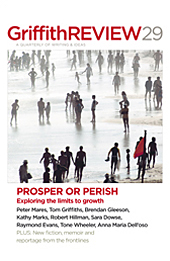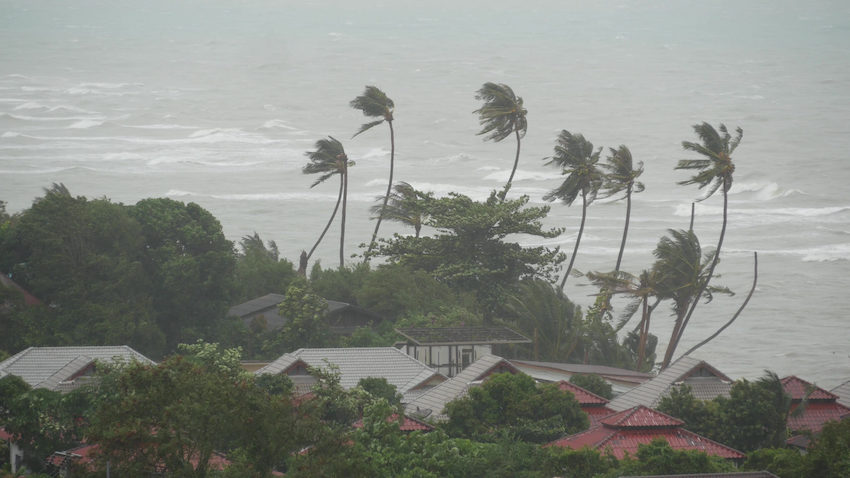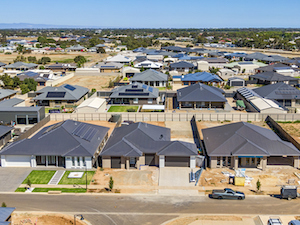Featured in

- Published 20100907
- ISBN: 9781921656170
- Extent: 264 pp
- Paperback (234 x 153mm), eBook
What‘s wrong with a bit of space? What‘s wrong with the possibility of being able to get to a beach and get onto the beach? The opportunity of going for a walk in a national park less than an hour‘s drive from the centre of the city? What‘s wrong with these things? What‘s wrong with having headlands still in a natural state? What‘s wrong with having magnificent coastal national parks? Why have we gotta cram this coastal strip with tens of millions more people?
– Former NSW Premier Bob Carr, 7.30 Report, January 2010
IN MARCH THIS year, the United Nations reported that 827 million people live in slums; vast dystopian alter-cities that shadow the citadels and suburbs of the wealthier. A slum is ‘a heavily populated urban area characterised by substandard housing and squalor’, though the generic term allows considerable variation, from ‘established’ areas of entrenched intergenerational poverty through to impermanent shanties brought hastily in to existence. While for millions of individuals slum life may be the totality of their experience on earth, the overall situation is dynamic. Outside of the fantasy of Slumdog Millionaire, it is still possible for people to make their escape; indeed, the UN estimates that almost a quarter of a billion people have escaped from slums since the turn of the millennium. Nevertheless an abundance of new arrivals has meant that the overall global slum population has risen in the last decade and is projected to continue to climb at the rate of around six million people annually for the foreseeable future. Already almost unimaginably immense, the slums are getting bigger.
The increase in the world’s slum population marks the grim junction of three grand historical trends. The first is the mass migration from the rural to the urban. In 2007, the pattern of human living crossed a threshold when the birth of a child or the passage of a person across the urban-rural divide meant that for the first time in human history, most of the species were living in towns rather than countryside. Second, the global population continues to expand radically. Two hundred years ago, there were around one billion people in the world; in 2001 the six billionth human being was born and the world’s tally is expected to grow by at least half that much again by 2050. Third, global inequality has increased over the last thirty years, coinciding with the period of neo-liberal ascendancy in ideology and policy making. The cumulative consequence is that there are more people on earth, who are increasingly likely to live in cities, in which ever larger numbers of residents exist in the shadows of deepening inequality.
We are now witnessing the emergence of mega-cities of staggering size, with spread, density and poverty that defy individual comprehension. Mexico City, Mumbai and São Paulo all currently hover just short of having twenty million inhabitants, all with huge slum areas. Among the fastest growing of the slum-dominated cities are the African giants Lagos and Kinshasa, each of which is expected to reach around sixteen million souls within the next fifteen years. Dhaka, one of the planet’s most vulnerable cities to climate change, is already the fourth largest metropolis in the world at fourteen and a half million and is set to add another eight million people by 2025. In each of these megalopolises and in smaller cities as well, from Rio de Janeiro to Delhi, Cairo to Karachi, and Palermo to Kibera, the masses seethe, struggling in a vast abridgement of human potential and expectation.
In 2006, a book by critical American social commentator Mike Davis was published under the memorable title Planet of Slums. The designation was well chosen, signifying not only the planetary scale and spread of slums, but also the extent to which the degradation of the alter-cities is another world of experience to the lived realities of the global middle and upper classes. Buildings are broken, dilapidated and often irregularly constructed. Transport is dangerous and overcrowded. Power and water supplies are of varying levels of scarcity and poor quality. Looping lines and broken or nonexistent pipes are common. Modern ablutions are largely unavailable and sewerage disposal is a constant problem. Worldwide, around 2.5 billion people do not have access to a basic toilet, with many slum dwellers among those who lack access to a safe and hygienic place to urinate, defecate and dispose of menstrual efflux. Air quality is often dire, preventable disease is endemic and some times epidemic, and diabolical pollution is rife. Whole communities may spring up on mountains of rubbish or slag heaps of industrial waste. The night sky may be invisible through the smog. Extreme poverty and dire congestion are omnipresent, as people live and sleep where space allows in the pullulating hive.
Slums are characterised not only by their physical environment, but the absence of the trappings of state. The promise of full civic participation in the life of the nation may be as elusive as adequate roofing, with violence and menace dousing the prospect of human liberties. Slums may be places of social cohesion, but they can also be sites of intimidation and brutality. In the absence of effective governance, slum lords and gangsters can exercise de facto rule. Slum dwellers are no more lacking in agency or creativity than human beings elsewhere on the planet, and people will endeavour to solve their own difficulties and improve conditions for themselves and their families with whatever means at their disposal. The cultivation of personal relationships with local despots may be the only way for an individual to attain a measure of security or to obtain assistance in problem solving. Local crime bosses and big men may even come to be regarded as performing a socially useful role in the absence of a viable public alternative. Then again, when agents of the state are present, they may be predatory, as policing and service provision are corrupted or captured by clientelistic networks rooted in the slum environment. In a career spent studying villa miseries in Argentina, sociologist Javier Auyero has documented the ‘gray zone’ in which ‘the activities of those perpetrating the violence and those who presumably seek to control them coalesce’.[i] Shades of legitimacy, violence and corruption are blended and lines become blurred. The gray zone of the slums is the apotheosis of liberal ambitions; the rout of a certain vision of inclusive citizenship.
There is only one lucky continent in which there are no slums at all. According to the United Nations Environment Program’s report The Challenge of Slums ‘[a]part from a few run-down suburban blocks and areas, Sydney no longer has any slums as is normally conceived, although there are many areas where disadvantaged people live in high concentrations’. The situation is no worse in any of Australia’s other cities. Australia is slum free. There used to be some true-blue Aussie slums, but the steady rise in living standards accompanied by public investment since World War II has taken care of those. Indigenous Australia provides the closest thing to slums anywhere in the continent, in the form of communities with demographic indicators that rival those of the developing world in terms of ill-health, over-crowding and the absence of opportunities to participate in the real economy. However, even the most squalid of Aboriginal settlements lack the scale to be considered a slum proper. Just to be clear though, to define the lived environment of those Aboriginal people and Torres Strait Islanders who experience a high degree of socio-economic deprivation as something other than slums is not to diminish the tragedy or complexity of their situation, nor to lessen the moral imperative for governmental engagement. Similarly, to note with gratitude Australia’s slumlessness is not to elide actual destitution where it does exist. The point though, is that the problems of poverty and social exclusion are of a different scale in Australia to every other continent.
THE METAPHOR OF the ecological footprint describes human demand on the earth’s biological carrying capacity. The implication is that an individual person, or a city or nation, may make a bigger imprint than their physical size suggests. A growth in population means an increased ecological footprint for a community, but so does an increase in consumption even if the number of individuals has not changed. World Wildlife Fund’s 2008 Living Planet Report provided a global snapshot of the environmental impact being made by each nation on earth. Australia’s ecological footprint was found to be around 7.8 global hectares per person; roughly 2.8 times the planetary average and well in excess of the 2.1 figure which is about what the planet can regenerate on an annual basis. It is an uncomfortable calculation that twenty-two million Australians are chewing through the fair share of more than sixty million, and doing so at a rate that is about four times what the Earth can manage. The consequences are as scientifically and mathematically plain as they are politically problematic: everyone in the world cannot live as Australians live. The material abundance of Planet Australia cannot be ecumenical; the biological limits of the world make this impossible. Further, the lifestyle that Australians strive to maintain is well beyond our mathematical entitlement.
The failure to situate Australia in the global context – the planet of slums – gives the population debate a perplexing hollowness. Beyond the abstract calculation of the share of the Earth’s resources to which each man and woman is entitled are tangible scientific processes and the hard facts of global political economy which bind us all together. The Australian good life is predicated on one of the highest per capita carbon emissions on Earth. Australia has also benefited from the system of global trade and investment which has made some nations and individuals richer, while committing others to extreme and enduring penury. The availability of ever cheaper consumer goods has been founded on an array of vast transnational networks of production and transportation, made possible by containerisation, computerisation and the internet, but still fundamentally reliant on low cost labour in developing countries. The planet of slums and Planet Australia, in other words, are one and the same world; each is the shadow of the other.
In a widely reported speech to the Commonwealth Parliament last August, Labor backbencher Kelvin Thompson began with a litany of planetary crises: ‘global warming, food crisis, water shortages, housing affordability, overcrowded cities, transport congestion, fisheries collapse, species extinctions, increasing prices, waste, terrorism’, each a problem which he said was ‘either caused by, or exacerbated by, the global population explosion’. It is time, Thompson went on to argue, for ‘governments and policy makers around the world to come to their senses and take steps to stabilise the world’s population… in every country, including here in Australia. Especially here in dry, arid Australia.’ Thompson’s forthrightness on a vexed public policy issue was thoroughly commendable, but his reasoning risked a bold illogic. The international scourges enumerated by Thompson are indeed global in character, but they cannot be meaningfully ameliorated by Australia limiting its own population intake. Less demand on Sydney’s West or Perth’s growth corridors does not reduce population pressures on Cairo or Lagos; it is a logical non sequitur. In practical terms, the effect of Thompson’s analysis is to make an argument for the maintenance of Australian privilege, not the alleviation of worldwide suffering.
IN AUSTRALIAN TERMS, anxieties about carrying capacity are not unreasonable, but the Australian continent is not an island entire of itself. Australia simply does not suffer from problems of over-population in any kind of way equivalent to the rest of the world now and won’t in relative terms even if the population was allowed to rise to thirty-five, forty, even fifty million by 2050. The truth is that underneath the population debate is something much harder; cognisance of the extent of Australian privilege and the phenomenon of over-consumption. The last year has demonstrated that it is possible for there to be a political conversation about population, but the notion that we cannot all lead lives designed around the untrammeled satisfaction of individual material desires remains largely unspeakable within the mainstream. As the global slum population surges upwards, Australia can indeed keep immigration to a minimum on the basis of a cautious approach to conserving national amenity. It should not be imagined though, that the consequence of pulling up the drawbridge will be anything other than preserving exclusivity, while outside the feasting window the many continue their earthly struggles in increasing desperation.
[i] J. Auyero, Routine Politics and Violence in Argentina: The Gray Zone of State Power, Cambridge University Press, Cambridge, 2007, p.32.
Share article
More from author

The ship, the students, the chief and the children
Non-fictionThe power of the fossil-fuel order depends on foreclosing any kind of political and institutional decisions that would see societies break free from the malignant clamp of coal, oil and gas corporations. This power also depends on eliding alternative ways of seeing. In one sense, the whole of the political struggle against climate change can be understood as an effort to make corporate and political decision-makers see, such that they are required to act.
More from this edition

Where is home?
MemoirWHEN I GET the urge to be elsewhere, as I sometimes do, it’s often my childhood home, Hong Kong. As I hanker for it,...

Monday morning in Mernda
ReportageWhen I visited the display homes at Mernda Villages, I was acutely aware that Mernda will be anything but a village once all the sites are sold, the houses built and the homes occupied.

Garden cities of tomorrow
EssayA PROJECTED AUSTRALIAN population of thirty-six million people by 2050 is being touted as a figure to fear. The pressure on food supply, lifestyle,...